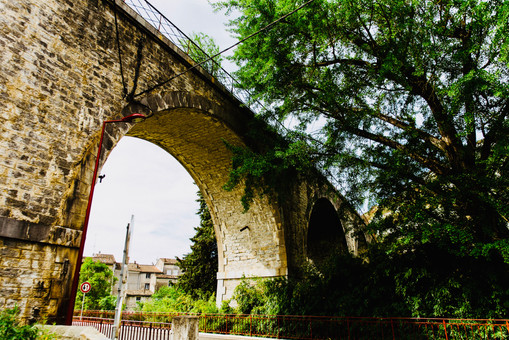For a town of our size, we have had more than our fair share of dramatic events. The population has hovered around 4000 for centuries, and honestly, it feels like a lot less. Surrounded by mountains, two rivers, and swaths of garrigue - scrubland scattered with brush and trees - this is the last place that would appear to threaten the powers that be.

Why then did King Louis XIV send 1200 fierce dragoons here in 1683 to suppress the Protestant Huguenots? It was still legal to be a Protestant in France at that time, making his actions all the more surprising.
And then the SS Nazis, searching for young men avoiding mandatory war work in Germany, swept down the same road in 1944 and installed themselves in the Château de Planque, where I now live and work. As a warning, they hung one young man, Roger Broussoux, under the bridge out front. The Nazis forced the family accused of sheltering him to watch his execution from the Château's second-floor windows.
A few years ago, a lovely neighbor in her 90s told me of her experience that day. In her 20s at the time (!) and unaware of what was happening, her mother sent her to buy bread. As she turned the corner, she saw Roger Broussoux hanging under the bridge. Visibly shaken, she told me she never returned to that boulangerie again. Indeed, it no longer exists.
Several others were killed that day in February 1944. Our mayor and his council honor them every year on the anniversary of their deaths. War veterans come out to stand and remember. Some would have been alive at the time of the events and clearly are still affected by the tragedy.
In both cases - Louis XIV's dragoons in the 17th century and the SS Nazis in the 20th, the Château de Planque became the headquarters for the invading forces. I try to imagine the scenes that unfolded here and wish the walls and rooms would share what they have seen. So far, they remain silent, so I try to learn as much as possible and imagine the rest.

I’ve recently finished writing the first book in a series based on these events called
Beyond Belief- Book one in the Huguenot Resistance series. I’m working towards publication in 2021.
History gives us some of the reasons this tiny town has drawn the attention of those in power while leaving many questions unanswered. I believe there is also a spiritual element, one we are still exploring.
The Cévennes is still known as a region full of Protestants, descendants of the Huguenots. My dental surgeon, fascinated that I live in St. Hippolyte-du-Fort, "with lots of Protestants," peppered me with questions and even pulled up Wikipedia to fact check while discussing my post-op routine.
Walking around town, I often see golden Huguenot cross necklaces worn by women - and sometimes men - young and old. It's a heritage they are rightfully proud of, and with which they still identify.
But by and large, throughout France, it is a little-known story. I've been told that priests often wrote the early histories and the "wars of religion" were not a proud moment for either Protestant or Catholic. Politics mixed with faith, atrocities, and bravery on both sides…but essentially, it was French people fighting their fellow countrymen and women

Dragoons were called "booted missionaries" as they forced Huguenot "heretics" to convert to the king's "one true faith."
At one point, the Huguenots of St. Hippolyte were forced to tear down their temple (church building). Stones were saved and used a few years later to build the Catholic church that still stands today. After that, the Huguenots simply carried on meeting for worship on the rubble, every single Sunday. That's when the Louis XIV decided to send the 1200 dragoons, who hung several young men and moved into homes throughout town to force conversions.

By 1685, the king revoked the right of Protestants to exist. At least 200,000 fled the country, through closed borders to Switzerland, Germany, Holland, England, and the United States and South Africa.
The Huguenots, being literate and educated, took their competencies with them: clock and watch-making to Geneva for example. They brought banking skills and a gorgeous silk fabric industry to London. Cape Town's wine region had its beginnings in this Huguenot diaspora. This unfortunate chapter in France's history- called the "brain drain"- was highly beneficial for the countries wherever the Huguenots landed.
I'm grateful to live today among the Huguenots' descendants and in a town known for its tenacity in holding on to what they believed. Last year, I had the privilege to speak to a group of local Catholics and Protestants who meet every Thursday for different activities. The pastor invited me to share what I had learned through the research for my book. It was nerve-wracking and a bit overwhelming to sit in a room full of French people and talk to them about their own history. And in my American-accented French!
Of course, they knew most of the stories, but a few new things were discovered. I was deeply moved to look around the room at these Christians' faces - both Catholic and Protestant - who are now neighbors and friends, focusing on what unites them rather than their differences.
And that is what makes life beautiful.









cool
billig hublot ure
billig iwc ure
It is incredible isn’t it? And it all wasn’t that long ago!
Wow, what a lot of history is contained in your home and your village - history that is close to my heart! Every village seems to have its story to tell, especially regarding the sufferings from WW2, every town a place some distance from houses, where Resistance members were shot. The memorial in Belle Isle en Terre is to Ernest Vallee and his brother, whose nephew was my son's headmaster!
Thank you Mickala!
LOVE this!